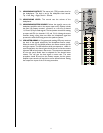
14
The S-14 has an extensive and impressive list of features and functions designed to make achieving good sound for
worship as easy as possible. To reach this goal, please carefully read and follow the planning and setup procedure
described below even if you are experienced with sound system setup. It will take a bit of time to complete the full
procedure but you will be rewarded with better sound and easier operation. As you go through this procedure, you
will notice that you will be asked to make many of the adjustments more than once. Because many mixer controls
affect other settings, the procedure is designed to help you zero in on proper settings. Ultimately, it is virtually
impossible to arrive at settings that never change. The goal here to get things as close as possible and make little
adjustments along the way as needed. Periodically, you may need to step back and repeat the setup procedure.
Once you go through the procedure a couple of times, it will actually go quickly, but you will want to allow an hour or two
the first time. To help with the setup process, we also include notes explaining the goals and reasons for the procedures.
NOTE: Although the analogy is an old one, it still applies here. A chain is only as strong as its weakest link.
Good sound starts with the microphone and ends with the speakers and the room. Each element plays an
important role in achieving good sound, and even the best equipment may not achieve the desired result if
improperly installed or used.
Setup Goal
Our overall goal is to get high quality sound from the mixer while letting it do as much of the work as possible.
With a little training, almost anyone should be able to successfully operate the S-14 once it is setup. Good results
should be obtained by just un-muting mics when needed and making an occasional adjustment of levels. If
microphones are moved or added, some additional adjustments will be required.
This is done by:
➧ Setting the Normal position faders on the Choir and Solo mics to 0. These faders may need to be adjusted
during use, but it is always nice to know 0 is a good starting point.
➧ Adjusting the automix channels so that the faders can generally be pushed to 0 if needed without feedback.
These are often channels where it is sometimes difficult to get enough gain and it’s nice to know where to stop.
➧ Adjusting the Compressors on the automix channels so they compress during loud speech but not at
normal speaking levels. This reduces the amount of manual adjustment needed.
➧ Setting the master faders at 0 (full up) so the system cannot be easily pushed into feedback.
➧ Adjusting the compressors on the Choir and Solo groups (if desired) to help control dynamic range. This
can be most useful on solo singers or small groups where mics are hand held. The result can be a better
mix that is easier to obtain.
➧ Adjusting the Noise Reduction on the Choir and Solo groups so when these microphones are not in use,
the gain is automatically reduced to help keep noise from these mics out of the sound system. This will
result in better reinforced-sound and better recordings.
➧ Setting the Feedback Ferret so common feedback frequencies are filtered ahead of time for the mics
normally used.
➧ Having the feedback ferret automatically detect and eliminate feedback if it occurs.
➧ Marking important settings on the S-14 so the controls can be returned to known good positions.
➧ By using AUTO-LEVEL circuitry to reduce dynamic range and by adding ambient room sound to the
sound system signal, recordings, broadcast audio and sound to other areas can be improved.
INSTALLATION


















